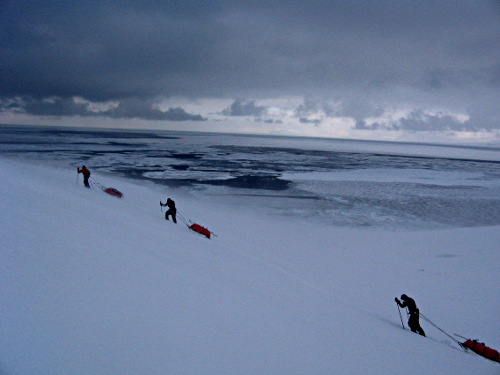
First stop? The rifle range.
“100 yards… 80 yards… 60 yards…! 50 yards”, and the air fills with screeches, pops and, finally, a booming noise that wrenches your gut and shakes the ground as smoke trickles from the barrel, the rifle’s wry acknowledgement of its attention grabbing action as the imaginary bear gets too close for comfort.
Polar bears require constant vigilance in Svalbard. Last time I was here, one of them strutted across the airport runway (a slightly more convincing explanation for transport delays than the “leaves on the track” we get over here) and later ate someone’s dog. But, generally speaking, you can consider yourself safe in town. Out and about, however, and someone amongst you should probably be carrying a weapon. In our case, we have a single rifle between us and we’re each carrying a small pen flare which looks a little like a small Maglite and whose incendiary delivery is not dissimilar to what I imagine Harry Potter’s wand might produce (bearing in mind I’ve never read any J.K. Rowling). My team mates all have military backgrounds so the only quibble is about who gets to carry the big gun and “Pop the sucker” when he arrives (although we’re aware, of course, that shooting a bear is a last resort and serious offence).
Imparted now with the requisite skills, arsenal and machismo to shoot the sixth Rambo film, all that remains is to learn how to ski. I’ve never had the opportunity to strap planks to my feet before – not even for those downhill holidays that people keep raving about – but how hard can it be? After half an hour impersonating a heavily drunken Bambi-on-ice, sliding my way down to town, and a good ninety minutes slogging my way back up cursing loudly as I suspect Bambi might the morning after, I discover skins.
There is an explanation of what skins are and how they work that is both technical and logical. But I don’t know it so I’ll just say that they are like long bits of Velcro that stick to the bottom of your skis and let you go forward whilst stopping you from sliding backwards. Couple those with thirty kilos worth of pulk (sled) behind you and skiing suddenly becomes less like tight-rope walking and more like walking in clown shoes: Not very graceful but infinitely easier.
Minus twenty sounds pretty cold doesn’t it? And I certainly make it sound that way when I tell this story down the pub but, in reality, once we got moving it was fine. The sun was shining, the air was still and the pleasant, mild exertion of dragging fibreglass over frozen snow made for a wonderful introduction to “polar exploring” (the quote marks indicate that we weren’t exploring anything that the multitude of skiddoos flying past hadn’t discovered with their clients earlier in the day).
Still, that didn’t stop me pushing my sunglasses up and pulling my balaclava down to say: “Joe, what’s that on your face?”
There are two things you need to keep checking for in this sort of environment. The first is bears and we had opted to address this particular need by crying “Bear Watch!” every few minutes followed by a series of nature documentary themed jokes (as well as scanning the horizon – the originally intended purpose). The second is cold injuries. For the most part, it’s easy to tell whether you and your extremities are hot or cold. Your face, however, remains at least partly exposed in anything but the most severe of conditions and it’s not always easy to tell the difference between chilly cheeks and the beginnings of frost-nip or -bite. Thankfully in this instance, the white blister that had appeared on Joe’s left cheek disappears swiftly with the application of a warm palm.
“What about over there?”, I offer with a point of the ski pole. “It’s fine here” responds Ed in reference to the patch of ground more notable for its immediate proximity to us than its properties as a good camp site.
“Ram it!”, comes the chorus of agreement from the team.
(This article was originally written for Adventure Travel Magazine)
What do you think? Please do add your thoughts below…